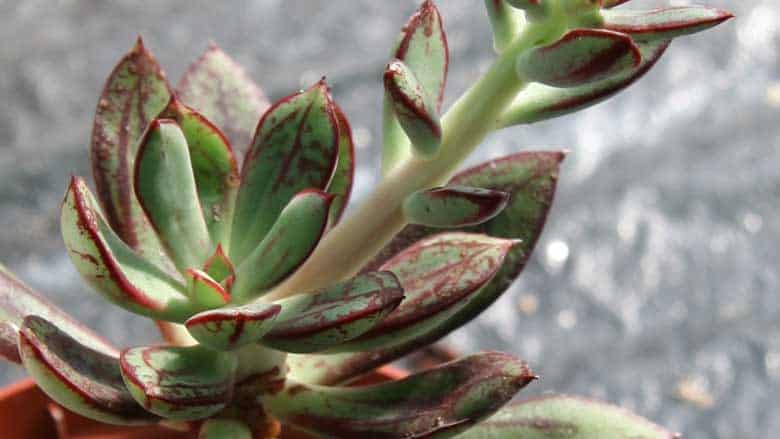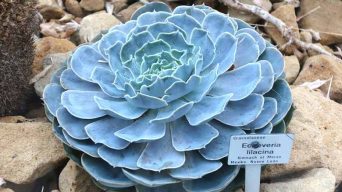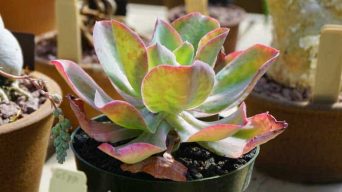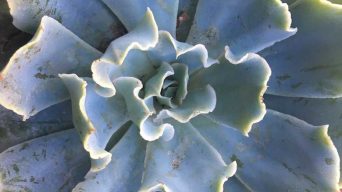Succulents are popular houseplants because they require very minimal care and can survive in the harshest environments with little water.
The Echeveria nodulosa, also known as Painted Echeveria, is a succulent plant that is a beautiful addition to any collection.
It’s easy to grow, making it a great starter plant for those just getting into gardening.
This guide will teach you everything you need to know about how to take care and propagate your Echeveria nodulosa (Painted Echeveria)!
Overview
The Echeveria genus is a large genus of flowering plants in the Crassulaceae family, native to semi-desert habitats.
There are at least 270 species of Echeveria worldwide, and 115 can be found naturally within Mexico alone.
One of the most popular Echeveria species is the Painted Echeveria (E. nodulosa). This Echeveria type is native to Mexico.
They grow in the shade on rocky slopes, among other vegetation, never losing their leaves during the dry season.
The Echeveria nodulosa, commonly known as the Painted Echeveria, is a succulent with its stems bearing rosettes of green leaves marked throughout with reddish lines.
The Echeveria nodulosa stem typically grows to be 8 inches (20 cm) tall. The leaves grow at a maximum of 2 inches (5 cm) and are up to 0.6 inches (1.5 cm) in width.
Once mature, the plant produces beautiful bell-shaped red or yellow flowers. They appear during the summer and may grow up to 2 feet tall.
In addition to being a beautiful succulent, the E.Nodulosa is also an excellent houseplant.
How To Care for Echeveria Nodulosa (Painted Echeveria)
Echeveria nodulosa care is not difficult, but it does require some attention.
The Echeveria plant is a low-maintenance succulent. These plants thrive indoors and outdoors, requiring little maintenance or care.
Sun Exposure & Light Requirements
Echeveria nodulosa thrives with a combination of full sun and partial shade.
This plant needs a moderate amount of sunlight. It should get at least a few hours of sun during the early morning or early afternoon.
This succulent prefers a location with some shade during the hottest part of the day. Placing it in an area that gets full sun for most of the day will cause scorching on its leaves and bleach out its color.
Echeveria nodulosa prefers indirect bright light, such as found near windows or beneath trees during dry weather conditions.
These plants do not like to be left in direct sunlight for too long because they are prone to sunburns from high temperatures if exposed without adequate protection.
Echeveria nodulosa will thrive when placed in areas exposed to bright sunlight intermittently, so make sure to give them some time away from their window perches every now and again if they’re too close!
Watering Requirements
Echeveria nodulosa is a succulent plant that needs less water than most other plants. You should only need to water this plant once every few weeks and, in rare cases, more.
The roots of the Echeveria are sensitive, so you want them to have as little contact with moisture as possible because they could rot or get infected if exposed for too long.
Echeverias like dry soil between watering sessions, but don’t let the potting mix completely dry out.
You should also be careful when watering because the leaves of an Echeveria can get spots if the water sits on them for too long or they are watered from a dirty source.
Echeverias are sensitive to too much water, so be sure not to overwater them, or you could end up killing it.
Soil Requirements
Echeveria nodulosa is a succulent that does well in dry environments and prefers to be planted in cactus soil. The soil should drain quickly.
Too much water can rot the roots of the plant or cause it to wilt.
The general rule is to use succulent or cactus soil. This type of soil drains quickly and is easy to find.
If you cannot find this, then a mix of sand and potting soil will also work but will take a little longer to dry out.
Temperature and Humidity
Echeveria nodulosa needs a temperature of around 65° to 72° degrees Fahrenheit.
If the temperature is too cold, it will not grow.
If the plant shows signs of frost damage or your nighttime temperatures drop below 50°F, you should consider moving them inside for the winter months.
Echeveria nodulosa (Painted Echeveria) likes a humidity of approximately 50%.
You may need to mist your plant daily if it falls below that level.
With good drainage and potting mix with plenty of air circulation, the succulent leaves will resist rot from developing on them.
Fertilizing
Echeveria plants are not heavy feeders and can easily be fertilized with a balanced diluted liquid fertilizer applied every other week.
The diluted liquid can be mixed in a container or directly into the soil at a rate of one teaspoon per quart of water.
The most important thing to remember about fertilizing any succulent plant is that it should not be overfed.
The plants should be watered after feeding, and this will help wash off any surplus that may have been applied.
Potting and Repotting
Echeveria nodulosa can be grown in any potting mix, but a cactus or succulent soil is ideal.
You should use porous containers such as clay or terra cotta pots and avoid plastic ones because they will retain too much water, leading to the plants rotting.
If you don’t have one of these types of vessels, then it is better to plant them in the ground than in anything else since Echeverias need excellent drainage.
Deeper pots provide more protection from frost during winter months and should have some gravel added at the bottom, if possible, for extra drainage.
Shallow pots dry out faster, but they are easier to move from one location of the house or garden to another.
When planting, ensure good drainage and plant at least two inches below the soil line not to let the roots rot in the wet potting mix.
When new growth begins, the best time for repotting this Echeveria succulent plant is in the spring or early summer.
Pruning
Echeveria nodulosa will need periodic pruning every year or two because the newer growth is usually more attractive than older leaves.
You don’t want a “leggy” looking Echeveria!
Pruning an Echeveria means removing some of its oldest leaves and shoots, which may be yellowed or brown in color, for fresh new green additions.
This process should also help keep your Echeveria from becoming too top-heavy by cutting off the older growth at the base of your Echeveria plant.
It’s best to trim off dead and dying parts before they spread their disease or rot onto the rest of the plant.
If no leaves are damaged on your Echeveria, use scissors for clean cuts and snip excess stem near its base using sharp shears.
Be sure you don’t cut into healthy live tissue from which new shoots could grow! If your Echeveria has yellowed leaves, you can trim off the yellowed area.
Pests and Diseases
Echeveria nodulosa succulent plant is vulnerable to some pests and diseases, including:
- Mealybugs
- Spider Mites
- Aphids
- Fungus Gnats
Mealybugs are one of the biggest threats to this type of succulent plant, as they can quickly infest plants by sucking out all their sap.
Spider Mites also pose a significant threat because they feed on Echeveria nodulosa’s leaves.
They also spread various viruses, such as Red Spider Mite Virus (RPMV), which will cause spots or patches to appear on your plant, turning them brown.
Aphids suck up nutrients from young shoots, causing them to be stunted in growth. They also transmit the lace bugs, which can cause deformation in your plant.
Fungus Gnats are another pest you will want to watch out for because they lay their eggs in moist soil, and then when they hatch, these larvae start feeding on the roots of plants, causing them to wilt or die.
If any of those pests above has invaded your Echeveria nodulosa succulent plant, it is best to kill all egg masses, pupae, or even larvae if possible, using a strong jet stream from a water hose.
You should also isolate infected plants away from other healthy ones and spray your plant down with insecticidal soap.
Root rot is the most common disease that will affect Echeverias.
This can be prevented by planting your plant in a well-draining potting mix.
Also, ensure it doesn’t sit in water for too long, overwatering, or sitting too close to an infected succulent, such as one with root rot.
Other diseases include Powdery Mildew which causes the leaves of plants to turn light brown or white and fuzzy while staying attached to the stem.
It also creates small black spots on leaves and stems where spores grow before spreading throughout the plant.
You can try to control Powdery Mildew by spraying plants with a fungicide.
It is also important to remove any water, organic debris or fallen leaves from the area around your plant to avoid them spreading spores and causing infection.
How to Care for Echeveria Nodulosa (Painted Echeveria) in Winter
Painted Echeveria care in winter is much the same as care in summer but with a few important differences.
When temperatures are below 50 degrees Fahrenheit (or about 11 degrees Celsius), we cannot provide enough heat to keep the soil from freezing and damaging the roots of your Echeveria nodulosa.
Once exposed to frost or ice, it can take up to three weeks for an echeveria’s leaves to recover!
In order for our succulent friends not only to survive cold winters but thrive during them – this special treatment will need to be applied.
Place the pot in a sheltered spot outdoors that receives morning sun at least until noon
This “sheltered” location should protect against winds, such as being close to other large plants or a wall.
Cover the top of the pot with two to three inches of organic mulch
This provides an insulating layer that can help keep moisture in and cold out, reducing damage from winter weather.
It also helps retain heat during early morning hours when temperatures are still very low.
Choose whatever type of organic material you prefer – straw or hay works well for this purpose!
Water sparingly (every few weeks) as needed
We want to water just enough so that all leaves remain fully hydrated but not soaked through.
In other words: don’t overwater your Echeveria! Be mindful if there is snow on the ground – this could lead to overwatering.
In the spring, when temperatures are consistently above 50 degrees Fahrenheit (or about 11 degrees Celsius), simply move your plant back outside and remove all mulch from around it.
Enjoy its blooms!
How To Propagate Echeveria Nodulosa (Painted Echeveria)
Echeveria nodulosa propagation is done from stem cuttings or leaf cuttings
Stem Cuttings
Stem cuttings from Echeveria nodulosa are the most common way to propagate this succulent.
- Remove healthy stem cuttings with at least two nodes, and remove any leaves that might be on the bottom node.
- Cut just below one of the nodes (this will encourage root growth).
- Allow it to callous for about seven days before potting in fresh soil or cactus mix.
- Place the cutting in a well-lit area with plenty of air movement.
- Water only when soil is dry to touch.
Echeveria nodulosa stem cuttings will take between four to six weeks to produce roots.
Once the cuttings have rooted, they can be planted in a container of potting mix and watered regularly.
Leaf Cuttings
Echeveria nodulosa leaf cuttings are super easy to take, and the results can be breathtaking.
- Cut a leaf from the succulent, making sure that it is at least as long as it is wide
- Allow to callous for about two days before potting in fresh soil or cactus mix.
- Make sure to water it regularly.
- Once roots start growing from the bottom of a leaf-cutting, plant in cactus mix or soil and keep well watered.
- Place under indirect sunlight with filtered light available at least part of the day if possible.
- Place in a pot with drainage holes.
- Keep out of direct sun and only water when soil is dry to the touch.
The roots will take a few months to grow long enough, with about six weeks being common.
Once it has rooted in its new pot fully and starts growing again, move into direct sun gradually over a period of three days each week until it can take full exposure at least eight hours per day.
Is the Echeveria Nodulosa (Painted Echeveria) Toxic?
The Echeveria nodulosa is not toxic to humans or animals.
But despite this, the Echeveria nodulosa sap may cause skin irritation in some individuals, so handle plants carefully.
If you touch a plant, wash your hands thoroughly afterward before touching anything else (especially sensitive areas like eyes).
Final Thoughts
Echeveria nodulosa, the Painted Echeveria, is a beautiful, hardy succulent plant that will grow well in most conditions.
It thrives best with more sun exposure and slightly moist soil but can be found in many different habitats.
As long as it receives the right amount of water each week (about once every two weeks), this succulent should do great!







